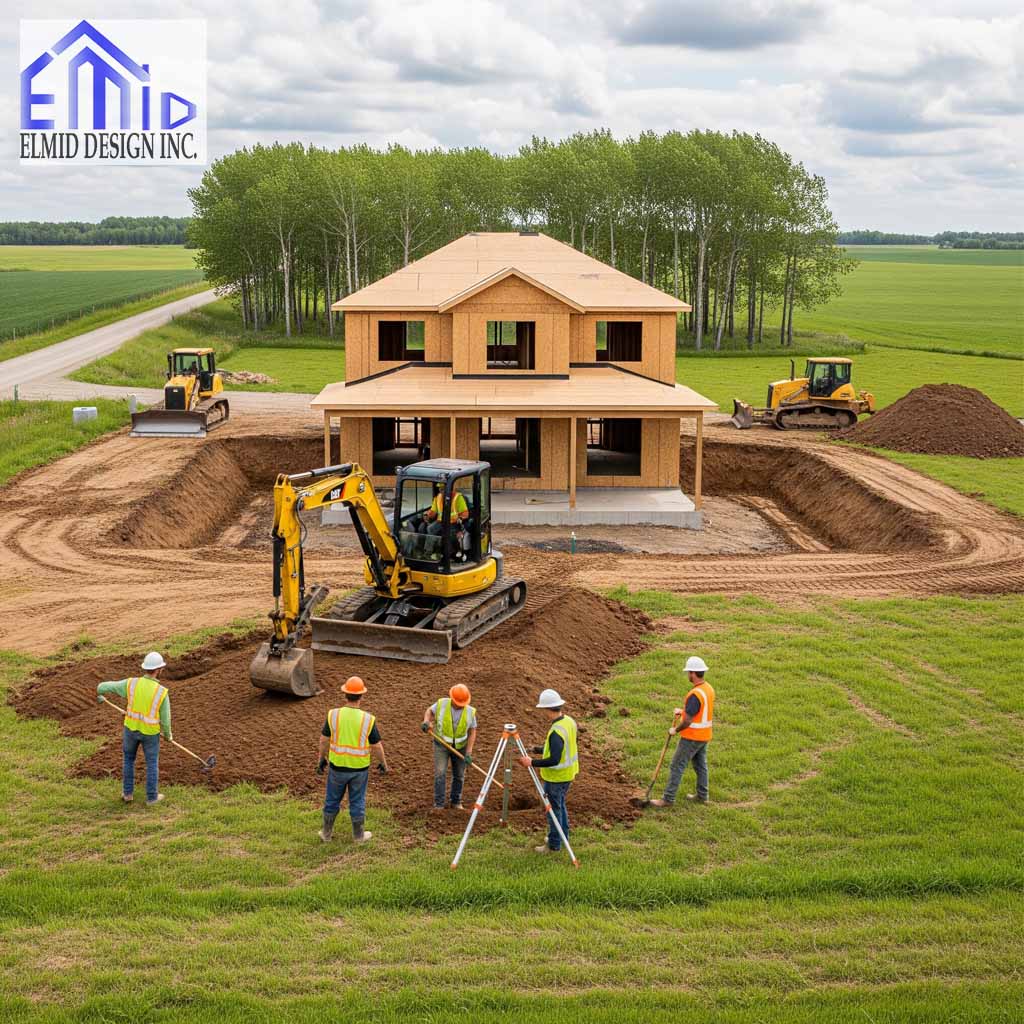A grading plan Bradford property owners submit plays a vital role in securing permits and protecting structures against drainage issues. In Bradford West Gwillimbury, all development projects must follow municipal standards that regulate how land is shaped and drained. Whether building a new home, adding a pool, or preparing a commercial site, you must include a grading plan with your permit application. This plan shows how surface water will flow, how the lot will be leveled, and how the project fits into the surrounding landscape. When done correctly, it supports smooth permit approval and long-term site stability.
What a Grading Plan Bradford Includes
A grading plan shows both existing and proposed land elevations for a specific site in Bradford. It outlines slope directions, key elevation points, and how surface runoff will exit the property without causing problems for nearby lots. It also marks important features such as swales, retaining walls, driveways, walkways, and building pads. The plan must be drawn to scale and follow local guidelines on slope percentages, lot coverage, and stormwater flow. Bradford officials use this plan to confirm that the design protects neighboring properties, avoids ponding, and supports sustainable development. A clear, accurate layout speeds up municipal review and inspection.
Why Bradford Requires Grading Plans
The Town of Bradford West Gwillimbury requires grading plans for developments that change how land drains or how elevation affects adjacent properties. These requirements protect homes and public infrastructure from water damage, especially during storms. Without grading control, runoff can lead to erosion, basement flooding, and municipal drainage failures. Grading plans also ensure developers meet local bylaws related to drainage, lot grading, and property transitions. By reviewing these plans before issuing permits, the municipality confirms that new projects respect the integrity of the surrounding land and meet all legal standards for safety and function.
Permit Applications and Grading Plan Submission
When applying for a building permit in Bradford, applicants must submit a grading plan prepared by a licensed professional engineer. The plan must be detailed, showing accurate elevations, slopes, and surface features. Any incomplete or non-compliant drawings are returned for revision. The town’s engineering department reviews these documents to make sure the design matches both the Ontario Building Code and local development guidelines. During this review, engineers confirm that water will not pool near buildings or spill onto neighboring properties. Timely submission of a correct grading plan helps move applications forward without unnecessary delays.
How Engineers Prepare a Grading Plan
A licensed engineer begins a grading plan by reviewing the topographic survey, which shows the natural contours of the land. They analyze how elevation and slope affect stormwater movement and use this data to develop a drainage layout. The engineer then designs new slopes that direct water away from the structure and toward safe outlets like swales or storm drains. The grading plan also coordinates with site servicing, such as sewer and water lines, to prevent conflicts. Engineers must ensure the layout supports construction goals while meeting all municipal requirements. Accuracy during this process ensures fewer issues later.
Importance of Topographic Survey for Bradford Grading
A topographic survey forms the foundation for every grading plan. In Bradford, land surveyors visit the property and record elevation points using advanced equipment. The survey shows how high or low each area of the lot sits relative to fixed reference points. These measurements allow engineers to calculate where water flows naturally and where grading changes must occur. Without a recent and reliable survey, drainage patterns might be misunderstood, leading to design errors or permit rejection. For every grading plan in Bradford, a valid topographic survey ensures both technical accuracy and municipal approval.
Slope Design and Drainage Flow in Bradford Projects
Grading plans in Bradford must follow specific slope guidelines to ensure water drains correctly from the site. Engineers calculate grades so that water flows away from building foundations and toward designated drainage routes. If slopes are too flat, water may pool near the structure. If they are too steep, erosion becomes a concern. Driveways, walkways, and lawns each require tailored slopes to perform properly without creating safety hazards. These slope percentages must meet local standards and align with the natural topography of the area. Proper slope design ensures drainage success and supports long-term land stability.
Municipal Guidelines for Grading in Bradford
The Town of Bradford West Gwillimbury outlines clear criteria that every grading plan must meet. These include minimum slope distances from foundations, swale dimensions, and runoff control requirements. Municipal engineering staff check each plan to confirm that no part of the lot sends water onto neighboring properties or public roads. Plans must show how surface features support drainage and how any retaining walls or landscape modifications affect flow. Infill developments and multi-unit projects often require additional details to account for tight site conditions. Following the town’s grading standards reduces back-and-forth with reviewers and speeds up approvals.

Conservation Authority Considerations in Bradford
In some areas of Bradford, conservation authority regulations apply when development is proposed near wetlands, floodplains, or environmentally sensitive zones. Before approving a grading plan, authorities such as the Lake Simcoe Region Conservation Authority review the design to ensure it protects water quality, limits erosion, and maintains existing drainage patterns. Engineers must follow setback requirements and may need to include erosion and sediment control strategies in the grading plan. This layer of review often adds time to the permitting process. However, early coordination with the authority helps prevent costly redesigns and avoids delays during construction or inspection stages.
Inspection Requirements During Construction
Once the municipality approves the grading plan, the builder must follow it exactly during construction. Inspections take place at key stages to verify compliance with the approved elevations and drainage features. Engineers or inspectors confirm that slopes, swales, and final grades match the submitted drawings. If differences are found, contractors must correct the grading before proceeding. Bradford’s inspection team focuses on areas around foundations, property lines, and swale alignment to prevent drainage problems. Regular field checks help avoid long-term issues such as flooding or erosion. Coordinated communication between the builder and engineer ensures a smooth inspection process.
Erosion Control for Active Building Sites
During excavation and grading in Bradford, exposed soil becomes vulnerable to erosion from rain or wind. If sediment leaves the site, it can block municipal sewers or damage natural features nearby. To prevent this, the grading plan must include erosion control measures that stabilize disturbed areas. These may involve placing temporary barriers, controlling water flow, or sequencing work to limit exposure. Municipal inspectors check these controls during site visits. Projects that ignore erosion protection risk enforcement actions or delays. A well-executed erosion plan ensures compliance, protects the environment, and maintains good standing with local authorities.
Final Grading Certification and Permit Closure
Once construction finishes, a professional engineer must return to the site and confirm that the final grading matches the approved design. They measure slopes, review drainage paths, and document compliance in a final grading certification letter. This letter, along with updated site drawings, must be submitted to the Town of Bradford to close out the permit. Without this certification, the municipality may withhold occupancy approvals or request further grading corrections. Timely submission of the certificate helps builders complete projects and transition to final inspections. Property owners also gain peace of mind knowing that the site drains correctly.
Maintaining Site Grading After Certification
Even after the municipality accepts the final grading, property owners remain responsible for maintaining all approved drainage features. Any changes to landscaping, driveways, or surface grades can impact how water moves across the lot. If runoff begins to pool near the house or spills onto neighboring properties, the town may require repairs or updates to restore proper drainage. In Bradford, homeowners must keep swales clear, preserve grading near structures, and avoid blocking drainage paths with hardscaping or fences. Regular visual inspections and quick action when erosion appears protect the investment and maintain compliance with the original design.
Grading Plans for Custom Homes in Bradford
Custom homes in Bradford often sit on irregular or larger lots, which require tailored grading solutions. These sites usually feature unique building footprints, complex elevation changes, or non-standard setbacks. Engineers must design slopes that work with the architecture while protecting foundations and neighboring properties from runoff. This involves coordinating with architects, builders, and surveyors to align design and function. In many cases, rear or side yard grading must transition smoothly into natural grades without compromising drainage. Accurate planning ensures the home integrates into the surrounding landscape without causing long-term issues or approval delays.
Addressing Corner Lot Grading Challenges
Corner lots in Bradford present grading complications due to multiple street frontages and limited slope directions. These properties must maintain proper drainage away from both roadways and nearby homes. Engineers often need to use split grades or multiple swales to move runoff to safe collection points. Driveway placement and sidewalk alignment can also limit options. In these cases, small design errors lead to water pooling or unwanted flows toward adjacent lots. Clear coordination between all site elements helps engineers maintain compliance with town grading policies. A well-prepared grading plan prevents runoff problems and ensures efficient drainage from every angle.
Managing Steep Slopes and Elevation Differences
In parts of Bradford, builders encounter steep slopes that make grading more difficult. Slopes that drop off sharply can lead to erosion, unstable soil, and drainage risks if not handled correctly. Engineers may need to include terracing, retaining walls, or gentle slope transitions in the grading plan to stabilize the site. These features must still meet municipal standards for swale depth, runoff direction, and property line protection. Getting the grade right on a sloped site requires careful survey interpretation and real-world feasibility. Addressing these terrain features early in the design phase supports safe construction and lasting drainage performance.
Pool Installation and Backyard Regrading
Installing a pool in Bradford usually requires changes to the yard’s grading and drainage layout. The new pool pad and surrounding patio area must not trap water or send runoff toward the house or neighboring lots. Engineers revise the grading plan to show how surface water will bypass the pool area while maintaining safe slopes. Any fencing, landscaping, or decking added later must also respect the approved drainage path. Bradford’s permit office reviews these plans closely to prevent future issues with water flow or erosion. Incorporating grading design into the early stages of pool planning avoids costly rework after construction.
Grading Design for Infill Developments
Infill projects in Bradford occur on smaller lots between existing structures, often with tight space constraints and limited slope options. Engineers must balance the drainage needs of the new construction with the established grading of adjacent properties. Plans must prevent runoff from entering neighboring yards or driveways and fit within the available setbacks. These tight parameters leave little room for error, making accuracy and precision essential. Survey data and site evaluation play a major role in creating compliant designs. Success depends on anticipating challenges and presenting a grading plan that respects both the lot’s conditions and the municipality’s rules.
How Elmid Design Inc. Supports Grading Success
Elmid Design Inc. brings engineering expertise and local knowledge to every grading plan in Bradford. As a firm with a Certificate of Authorization from Professional Engineers Ontario, they prepare plans that meet all town requirements and support fast permit approval. Their team works directly with property owners, builders, and surveyors to ensure every grading solution fits the site and complies with zoning, servicing, and drainage standards. Elmid Design Inc. also handles field verification and final certification, helping projects move from planning to occupancy without delays. Their attention to detail and experience in Bradford’s regulations help reduce costly revisions and improve long-term grading performance.
Restoring Grading After Excavation and Construction
Once excavation and foundation work finishes, contractors must restore the site to match the approved grading plan. This phase includes reshaping the land to achieve the proper slopes around structures, swales, and lot boundaries. Builders work closely with engineers to confirm that all final grades meet the design intent. Delaying restoration increases the risk of drainage problems, soil displacement, and foundation exposure. Proper compaction of backfill and careful grading around the house help prevent future settlement and water intrusion. Restoration also ensures that inspections go smoothly and that final certification can be issued without revision or delay.
Seasonal Impacts on Grading in Bradford
Bradford experiences seasonal weather shifts that affect grading plans and construction schedules. During spring, thawing soil and increased rainfall demand robust drainage strategies to avoid pooling and runoff. In winter, frozen ground limits excavation, making late-season grading more challenging. Engineers must consider these seasonal patterns during design to ensure long-term performance. Construction teams should schedule grading work when soil is stable and dry enough for shaping. Poor timing can lead to compacted soil, slope failure, or erosion that requires costly rework. Accounting for seasonal limitations in the plan improves build efficiency and long-term grading integrity.
How to Pass a Grading Inspection in Bradford
To pass grading inspections in Bradford, builders must follow the approved plan exactly. Inspectors focus on slope direction, swale alignment, and surface drainage functionality. Before inspection, the site must be clean, with no obstructions in swales or unfinished areas that could affect water flow. Engineers often conduct pre-inspections to ensure that all grades match the design. If changes occurred during construction, the engineer must update the drawings before submitting for final certification. Inspections go more smoothly when the engineer, builder, and inspector communicate clearly. Staying aligned with the plan throughout construction helps avoid unexpected corrections or delays.
Preventing Drainage Failures After Construction
Once the property is graded and certified, the responsibility shifts to the owner to prevent drainage failures. Over time, changes to landscaping or surface features can block water flow and disrupt swale performance. Even planting beds or paving additions may alter the slope enough to redirect water toward the home. Regular maintenance and awareness of how water moves across the lot help avoid these issues. If water begins to pool or erosion appears, owners should contact their engineer to assess the site. Ongoing monitoring ensures that drainage remains functional and compliant long after the permit process ends.
FAQs About Grading Plan Bradford
Do I need a grading plan for every building project in Bradford?
You need a grading plan for most new builds, additions, pool installations, and any changes that affect how water drains on or from the lot.
Who prepares the grading plan for a property in Bradford?
Only licensed professional engineers or Ontario land surveyors with proper credentials can legally prepare and seal grading plans for submission.
What does a grading plan include in Bradford?
It includes existing and proposed elevations, slope direction, swales, retaining walls, drainage flow, and any site features that affect runoff.
How long does it take to get a grading plan approved?
If the plan is complete and complies with municipal standards, approval can take between one and three weeks, depending on town workload.
What happens after grading is certified?
After certification, the property owner must maintain the approved grading. Any changes to elevation or drainage may require reassessment.
Does conservation approval apply to every project?
Not every project, but any property near wetlands, flood zones, or sensitive areas may need additional review by the conservation authority.

Elmid Design Inc: Bradford’s Trusted Grading Plan Experts
Elmid Design Inc. is a licensed engineering firm specializing in grading plans for residential and commercial projects across Bradford. With a Certificate of Authorization from Professional Engineers Ontario, the firm provides accurate, code-compliant designs tailored to local drainage, zoning, and permit requirements. Their team works directly with builders, surveyors, and municipal staff to streamline approvals and deliver efficient site solutions. Elmid Design Inc. is known for precise drawings, reliable turnaround times, and deep knowledge of Bradford’s engineering standards, making them a preferred partner for land development and property improvement projects.
Geographic Locations That We Service:
Our Licensed Professional Engineers specializing in Engineered Site Grading Plans offer the best-engineered site grading plan, lot grading and erosion plan, and drainage plan to obtain site plan approval and building permits in Ontario, including a wide range of municipalities. Each area boasts unique features and requirements, making our tailored approach essential for success.
Toronto and Surrounding Areas
In the vibrant heart of Ontario, we service Toronto (City of Toronto) and surrounding areas. Additionally, we cover Oshawa (City of Oshawa), Pickering (City of Pickering), and Clarington (Municipality of Clarington). Furthermore, our expertise extends to Ajax (Town of Ajax), Whitby (Town of Whitby), Brock (Township of Brock), Scugog (Township of Scugog), and Uxbridge (Township of Uxbridge).
Halton Region
Moving to the Halton Region, our services encompass Burlington (City of Burlington) and Halton Hills (Town of Halton Hills). Also included are Milton (Town of Milton) and Oakville (Town of Oakville).
Peel Region
In the Peel Region, we provide services in Brampton (City of Brampton), Mississauga (City of Mississauga), and Caledon (Town of Caledon).
York Region
Our services in the York Region cover Vaughan (City of Vaughan), Aurora (Town of Aurora), and East Gwillimbury (Town of East Gwillimbury). We also cater to Georgina (Town of Georgina), Markham (City of Markham), Newmarket (Town of Newmarket), Richmond Hill (City of Richmond Hill), Whitchurch-Stouffville (Town of Whitchurch-Stouffville), King (Township of King), and Bradford-West Gwillimbury (Town of Bradford-West Gwillimbury). Each municipality here offers a distinct setting, requiring our specialized approach.
Other Southern Ontario Cities and Towns
We also serve many other cities and towns in Southern Ontario. These include Hamilton (City of Hamilton), St. Catharines (City of St. Catharines), Niagara on the Lake (Town of Niagara on the Lake), Brant (County of Brant), Cambridge (City of Cambridge), Kitchener (City of Kitchener), Waterloo (City of Waterloo), and Woodstock (City of Woodstock). Furthermore, we operate in Guelph (City of Guelph), Centre Wellington (Township of Centre Wellington), Shelburne (Town of Shelburne), Orangeville (Town of Orangeville), New Tecumseth (Town of New Tecumseth), Essa (Town of Essa), Collingwood (Town of Collingwood), Wasaga Beach (Town of Wasaga Beach), Barrie (City of Barrie), Midland (Town of Midland), Orillia (City of Orillia), Ramara (Town of Ramara), Minden Hills (Town of Minden Hills), North Kawartha (Town of North Kawartha), Kawartha Lakes (City of Kawartha Lakes), Peterborough (City of Peterborough), Selwyn (Town of Selwyn), and Brighton (Municipality of Brighton).




